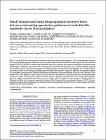| dc.contributor.author | Ó Marcaigh, Fionn | en |
| dc.contributor.author | Marples, Nicola | en |
| dc.date.accessioned | 2022-10-25T15:04:45Z | |
| dc.date.available | 2022-10-25T15:04:45Z | |
| dc.date.issued | 2022 | en |
| dc.date.submitted | 2022 | en |
| dc.identifier.citation | Fionn Ó Marcaigh, David J Kelly, Darren P O Connell, Kangkuso Analuddin, Adi Karya, Jennifer McCloughan, Ellen Tolan, Naomi Lawless, Nicola M Marples, Small islands and large biogeographic barriers have driven contrasting speciation patterns in Indo-Pacific sunbirds (Aves: Nectariniidae), Zoological Journal of the Linnean Society, 2022 | en |
| dc.identifier.issn | 0024-4082 | en |
| dc.identifier.other | Y | en |
| dc.identifier.uri | http://hdl.handle.net/2262/101492 | |
| dc.description | PUBLISHED | en |
| dc.description.abstract | Birds of the Indo-Pacific have provided biologists with many foundationalinsights. This study presents evidence for strong phylogeographic structure in two sunbird species from the heart of this region, the olive-backed sunbird, Cinnyris jugularis, and the black sunbird, Leptocoma aspasia. We assessed population divergence using morphological, plumage, bioacoustic and molecular data (mitochondrial ND2/ND3). Our findings indicate that the olive-backed sunbird should be recognized as multiple species, because birds from Sulawesi and the Sahul Shelf are closely related to each other, but widely separated from those in other regions. In addition, we provide evidence for an endemic species on the Wakatobi Islands, an archipelago of deep-sea islands off south-east Sulawesi. That a small bird could exhibit a range all the way from Sulawesi to Australia, while diverging on a small archipelago within this range, illustrates the complex interplay between dispersal and speciation. Our black sunbird genetic data also suggest unrecognized population structure, despite relatively weak plumage divergence. Black sunbirds in Sulawesi are likely to be a separate species from those in New Guinea, with a mean genetic distance of 9.1%. Current taxonomy suggests these sunbird species transcend classic biogeographic barriers, but our results suggest that these barriers are not easily bypassed. | en |
| dc.language.iso | en | en |
| dc.relation.ispartofseries | Zoological Journal of the Linnean Society | en |
| dc.rights | Y | en |
| dc.subject | Birds | en |
| dc.subject | Dispersal | en |
| dc.subject | Evolution | en |
| dc.subject | Island biogeography | en |
| dc.subject | Passeriformes | en |
| dc.subject | Taxonomy | en |
| dc.subject | Zoogeography | en |
| dc.title | Small islands and large biogeographic barriers have driven contrasting speciation patterns in Indo-Pacific sunbirds (Aves: Nectariniidae) | en |
| dc.type | Journal Article | en |
| dc.type.supercollection | scholarly_publications | en |
| dc.type.supercollection | refereed_publications | en |
| dc.identifier.peoplefinderurl | http://people.tcd.ie/omarcaif | en |
| dc.identifier.peoplefinderurl | http://people.tcd.ie/nmarples | en |
| dc.identifier.rssinternalid | 247290 | en |
| dc.identifier.doi | http://dx.doi.org/10.1093/zoolinnean/zlac081 | en |
| dc.rights.ecaccessrights | openAccess | |
| dc.subject.TCDTag | BIOGEOGRAPHY | en |
| dc.subject.TCDTag | BIRDS | en |
| dc.subject.TCDTag | Birdsong Analysis | en |
| dc.subject.TCDTag | EVOLUTION | en |
| dc.subject.TCDTag | INDONESIA | en |
| dc.subject.TCDTag | ISLAND BIOGEOGRAPHY | en |
| dc.subject.TCDTag | Sulawesi | en |
| dc.identifier.rssuri | https://doi.org/10.1093/zoolinnean/zlac081 | en |
| dc.identifier.orcid_id | 0000-0002-0591-5053 | en |
| dc.status.accessible | N | en |
| dc.contributor.sponsor | Irish Research Council (IRC) | en |
| dc.contributor.sponsorGrantNumber | GOIPG/2017/1618 | en |
| dc.contributor.sponsor | Irish Research Council (IRC) | en |
| dc.contributor.sponsorGrantNumber | GOIPG/2014/13046 | en |




